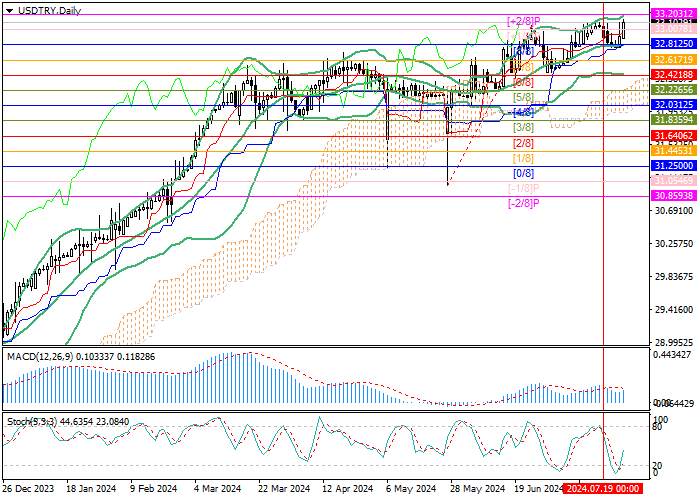Current trend
The USD/TRY pair is moving within a long-term upward trend, holding near its year’s high of 33.2031 during the Asian session.
Last Tuesday, the Monetary Policy Committee of the Central Bank of Turkey, considering the delayed effects of the tightening of parameters, kept the key rate for the weekly REPO auction at 50.0%. The officials emphasized the slowdown in core inflation according to the results of June statistics and noted that the trend is likely to change this month under the influence of non-monetary factors but will have a limited period. In turn, the Justice and Development Party led by President Recep Tayyip Erdogan is preparing a series of measures to expand the tax core and tighten fiscal policy to slow down the inflation rate. Thus, it is planned to introduce a low rate for businesses of 10.0%, which will be applied regardless of existing benefits (currently, the nominal corporate tax rate is 25.0%). This initiative continues the course of rationalization of economic policy, which began last year with an increase in value-added tax and excise taxes on fuel. It is worth noting that analysts positively assess the authorities’ efforts to stabilize the economy: experts from the international rating agency Moody’s have raised their assessment of Turkey’s credit situation by two notches at once to B3 stable, maintaining the country’s rating at the positive level. The International Monetary Fund (IMF)’s renewed World Economic Outlook report notes that gross domestic product (GDP) may grow by 2.7% next year, up from a previous estimate of 3.2%, and by 5.7% in the first quarter, one of the fastest rates in the world at the start of a year, driven by robust domestic demand despite tight monetary policy.
Today at 14:30 (GMT 2), investors will be looking at the June dynamics of the US personal consumption expenditure price index. It may rise from 0.0% to 0.1% MoM and consolidate at 2.6% YoY, while the core figure may change from 0.1% to 0.2% MoM and remain at 2.6% YoY. Slowing inflation will be another key argument for the US Fed to reduce borrowing costs following the September and December meetings. However, weekly data on the labor market demonstrated its resilience. Initial jobless claims increased by 235.0K, which was lower than both the forecast of 237.0K and the previous figure of 245.0K, while the total claims decreased from 1.860M to 1.851M.
Support and resistance
The trading instrument is moving within a long-term upward trend. This week, it tested 32.8125 (Murrey level [8/8]), supported by the middle line of Bollinger Bands but could not break below it and resumed growth. Currently, the quotes are approaching 33.2031 (Murrey level [ 2/8], the area of year’s highs), consolidation above which will allow them to reach the target of 33.7650 (Fibonacci extension 61.8%). In case of a breakdown of 32.8125, a decline to the area of 32.4218 (Murrey level [6/8], the lower line of Bollinger Bands), 32.0312 (Murrey level [4/8]) may follow.
Technical indicators allow for the continuation of the upward dynamics: Bollinger Bands are horizontal but the MACD histogram is increasing in the positive zone, and Stochastic is directed upwards.
Support levels: 32.8125, 32.4218, 32.0312.
Resistance levels: 33.2031, 33.7650.

Trading tips
Long positions may be opened above 33.2031, with the target at 33.7650 and stop loss 32.9000. Implementation period: 5–7 days.
Short positions may be opened below 32.8125, with the targets at 32.4218, 32.0312 and stop loss 33.0700.




Hot
No comment on record. Start new comment.